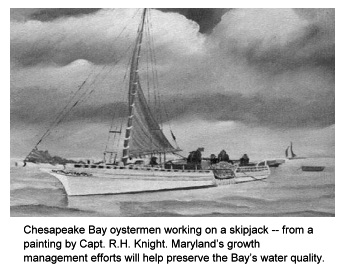 Through the 1960s, community and regional planning efforts were generally directed to the accommodation of growth as dictated by market forces. Planning focused on the provision of infrastructure needed to facilitate the continued expansion of urban centers as the market dictated. But a series of closely grouped actions in the early 1970s laid the foundation for the now widely accepted concept of “growth management.”
Through the 1960s, community and regional planning efforts were generally directed to the accommodation of growth as dictated by market forces. Planning focused on the provision of infrastructure needed to facilitate the continued expansion of urban centers as the market dictated. But a series of closely grouped actions in the early 1970s laid the foundation for the now widely accepted concept of “growth management.”
- Ramapo, New York, a township about thirty miles north of New York City, established a point system, based on its comprehensive plan policies and linked to its capital improvements program, for determining whether proposed developments could be approved. In upholding this then-novel approach to regulating development, New York’s highest court noted that: “The Town … has utilized its comprehensive plan to implement its timing controls and has coupled with restrictions provisions for low and moderate income housing on a large scale. Considered as a whole it represents both in its inception and implementation a reasonable attempt to provide for the sequential, orderly development of land.” Golden v. Planning Bd. of Ramapo (1972 – link is to pdf of court decision).
- Petaluma, California, an agricultural community north of San Francisco, limited the total number of building permits to be issued in any one year for large-scale developments. The permit caps were based on the town’s establishment of a target population for itself well below that which building trends would otherwise have resulted in.
- Livermore, California, imposed a moratorium on new residential construction until after the city completed improvements to its schools, and to its sewer and water systems.
- The State of Oregon established a state land use system requiring each communities and counties to create “urban growth boundaries” so that the state’s natural environment — from its rich river bottom soils to its rugged coastline and wooded hillsides — would be preserved.
The above actions shared a recognition (manifested even earlier in Lexington, Kentucky, see F is for Farmland) that the direction and extent of urban expansion is heavily influenced by public investment in the provision of roads, transit, schools, and water and sewer services. Through control over the timing and availability of these services, growth could be curtailed in certain areas and redirected to other portions of the community.
Growth management policies, when broadly viewed, deal with not just new facilities and their location, but with the continued vitality of older facilities. Indeed, reinvesting in older facilities often reduces the need for major state and local expenditures to provide new infrastructure (whether in the form of new schools or new sewer lines).
 Perhaps the most noteworthy recent example of this broader view of growth management can be seen in Maryland. The State acted to stop construction of new major access roads and to focus state funding for public facilities on extensions of existing community centers and transit served districts. State lawmakers recognized that existing growth patterns were having disastrous impacts on the state, both environmentally and fiscally. Poorly planned growth was threatening the water quality of the state’s “crown jewel,” the Chesapeake Bay — critical to the livelihood of thousands of Marylanders, from oystermen to individuals providing tourist-related services — and forcing the state to absorb the steep cost of freeways, schools, and other infrastructure to accommodate increasingly scattered, low-density development. Growth management meant fiscal and environmental responsibility.
Perhaps the most noteworthy recent example of this broader view of growth management can be seen in Maryland. The State acted to stop construction of new major access roads and to focus state funding for public facilities on extensions of existing community centers and transit served districts. State lawmakers recognized that existing growth patterns were having disastrous impacts on the state, both environmentally and fiscally. Poorly planned growth was threatening the water quality of the state’s “crown jewel,” the Chesapeake Bay — critical to the livelihood of thousands of Marylanders, from oystermen to individuals providing tourist-related services — and forcing the state to absorb the steep cost of freeways, schools, and other infrastructure to accommodate increasingly scattered, low-density development. Growth management meant fiscal and environmental responsibility.
